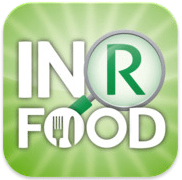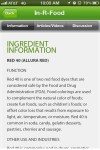North Carolina-based INRFOOD aims to add some much-needed context to the food we eat every day by highlighting all the (occasionally funky) ingredients that tend to appear in it. To that end, the bootstrapped startup just launched its iOS and Android app on the TechCrunch Disrupt SF stage and it’s clear that the team wants to bring that age-old adage about watching what you eat into the 21st century.
“There’s so much misinformation when it comes to diet,” founder Keval Mehta told me. “And it all depends on who you listen to.”
The way Mehta (a veteran of two other health-oriented companies) looks at it, people purchasing food pay too much attention to calorie counts and marketing jargon while the most important stuff to take note of — the ingredient list — too often gets ignored. The fact that those ingredients are printed out in a terribly tiny font doesn’t exactly help, and neither does the tendency for those lists to contain things that are nigh-unpronounceable.
That’s where INRFOOD comes in. When a new user fires up the freemium app for the first time they’re prompted to sign up for the service, but there’s a bit of a twist. In addition to creating the usual login credentials, they’re also asked if they adhere to any dietary restrictions because of a medical condition or a lifestyle choice — if a user has a shellfish allergy, a baby on the way, or is a vegan, the app wants to know about it. It’s a purely optional step, but one that dramatically enhances the INRFOOD experience (more on that later).
Anyway, from there, users can punch in names of food products they’re curious about as well as scan UPCs of prepackaged products to bring up a color-coded list of ingredients — green ingredients are safe, yellow ingredients should only be ingested in moderation, and red ones should be avoided. Tapping on any of them brings up a surprisingly comprehensive writeup (thanks to a team of dietitians and nutritionists INRFOOD has worked with) of the ingredient’s origins, uses, and health effects, and users can pop over to the Articles/Videos tab to access pertinent information from multiple external sources in case they need a bit more convincing.
“The only way to be disruptive is to have hard facts,” Mehta explained. “It’s a whole new world when people focus on what those ingredients are capable of doing.”
Now remember that dietary restriction bit I mentioned earlier? If a user, say, has a gluten allergy, the app will throw up a warning notification when a user searches for a problematic food. On top of that, users can save foods they’ve searched/scanned for to their “plate,” which provides a running total of how many times they’ve consumed a particular ingredient, complete with nifty graphs to illustrate the point.
INRFOOD wants to remain as impartial and as neutral as possible, so the team has resisted the temptation to load up the app and site with ads (“We want to be like Consumer Reports, or Switzerland”), so the onus of monetization falls on the app’s features. The scanning feature, My Plate analytics, color-coded ingredient lists and dietary alerts only remain active for 30 days before they need to be reactivated with a one-time $2.99 payment. That fee also unlocks new functionality too — think shelf life indicators and cooking methods for scanned/searched foods.
Of course, a service like this can only be as good as the database of product and ingredient information behind it, and thankfully the one that INRFOOD has been working on is no slouch. According to Mehta, the INRFOOD database plays home to 250,000 food products (with between 100 and 150 new products being added to mix daily) and 15,000 individual ingredients, which Mehta claims makes his the largest ingredient database in the world.
INRFOOD works like a treat (ha!) as is, but there’s still plenty more for Mehta and his team to hash out — he says the app in its current form only accounts for about 5% of his overall vision for the service. There’s a related spin-off in the works called INRBODY that seeks to shed light on the components in skin care products and the like, and Mehta is also considering adding a nifty augmented reality mode to the app. Some ambitions are grander than others though. The INRFOOD backend is capable of storing anonymous demographic information as well — think age, gender, weight, etc. — given enough users, that sort of data could prove useful to medical researchers looking to find relationships between certain foods and medical conditions, but for now Mehta’s focus is all about getting INRFOOD out into the wild.






